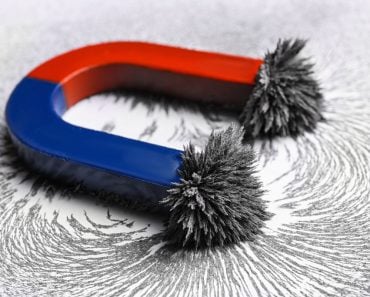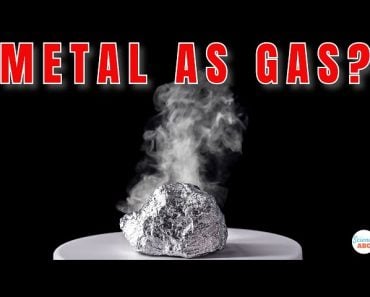Table of Contents (click to expand)
Yes, permanent magnets do lose a negligible amount of magnetism over time due to heat, mechanical damage, corrosion, and improper storage.
Whiskey, denim, leather boots and jackets, your 401(K)s, and even those pesky allergies are a few things known to get better with time, but the same is not true for magnets.
Fridge magnets are known to fall off after a couple years, and toy magnets similarly lose their strength over time. In practice, so-called ‘Permanent Magnets’ aren’t truly permanent.
Demagnetization—the process of reducing or eliminating a magnet’s magnetic capabilities—is generally done artificially, but can occur naturally too.
Extreme temperature fluctuations, loss of volume due to mechanical damage, improper storage, hysteresis loss, and corrosion can all prompt a magnet to lose its magnetism over the long term.
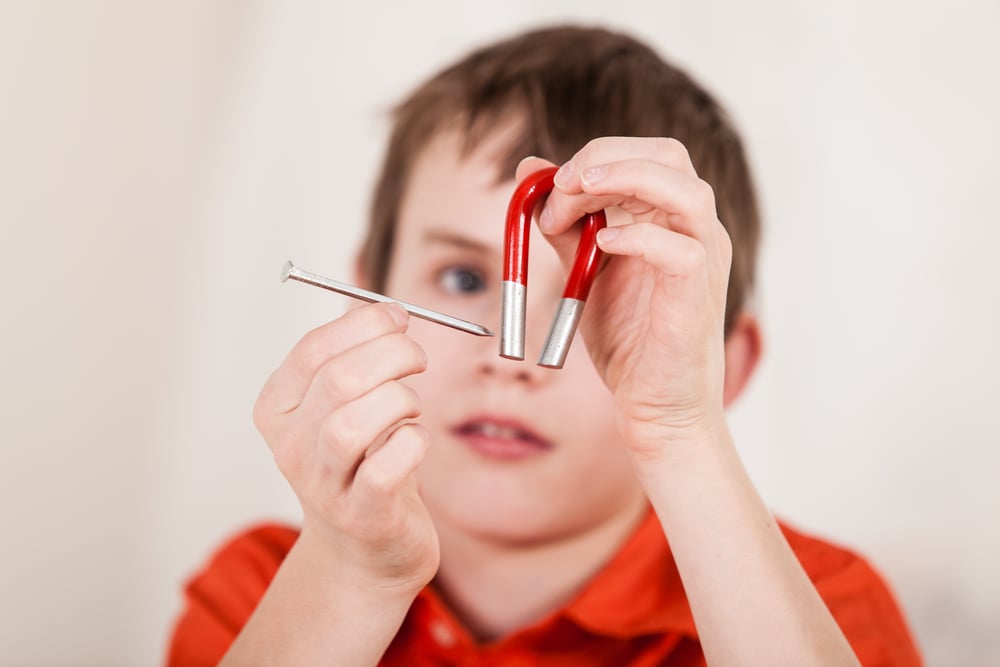
Recommended Video for you:
Magnetism
Before we learn more about how a magnet loses its magnetism, let’s try to understand what causes it in the first place.
Magnetism is one of the four fundamental forces of nature and results from the motion of charged sub-atomic particles, particularly electrons. These negatively charged particles constantly orbit around the nucleus, while also rotating about their own axes. The latter of the two movements, formally known as electron spin, is an intrinsic property and contributes in a major way to the generation of attractive or repulsive forces, which we call magnetism.
In simple terms, the orbital and spinning movements are considered to generate an electric current (flow of electrons), which causes individual electrons to act like tiny magnets (electromagnetism). Each of these movements creates their own magnetic dipole (orbital magnetic dipole moment and spin magnetic dipole moment, respectively) and combine to generate a net atomic magnetic dipole moment.
(Nucleons, protons and neutrons also rotate about their axes and add to the net magnetic moment of an atom, although their contribution is 1000 times smaller than electrons’ effect, and therefore negligible.)
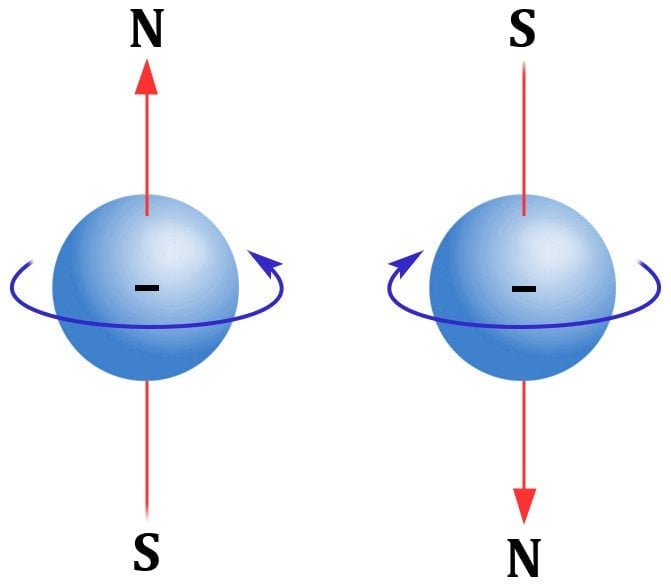
Pauli’s Exclusion Principle
Now, if each electron is a tiny magnet and every piece of matter contains trillions of them, why isn’t everything around us magnetic?
Answer – Because most electrons cancel out each other’s magnetism.
According to Pauli’s exclusion principle, electrons present in the same orbital shell have opposite spins and therefore cancel each other’s magnetic prowess. In certain elements, such as iron and cobalt (ferromagnetic materials), the final valence shell is only half-filled and contains unpaired electrons.
With no opposing electrons to neutralize them, these unpaired electrons collectively bestow their respective atoms with magnetic powers.
When forming a crystal, atoms can either align their magnetic moments in the same direction or not, depending on what results in the least internal energy. Regions in which the individual magnetic moments are parallel to each other (aligned) are known as magnetic domains.
The response of these domains and individual atoms to an applied external field forms the basis for the classification of various magnetic materials (Types of magnetic materials).
An element or material starts behaving like a permanent magnet when every magnetic domain is aligned in the same direction after the application of an external magnetic field.

What Causes A Loss In Magnetism?
A magnetic material isn’t truly magnetic unless its domains are accurately aligned; a change in the direction of any single domain can lead to a loss in net magnetic strength. Various natural factors can prompt these domains to randomize. The most common and destructive one being excessive heat.
Heat
While everything may seem quiet on the surface, at the microscopic level, atoms are constantly vibrating. The extent of their vibration depends on their energy state, which depends on their temperature. Any slight fluctuation in temperature affects the intensity of atomic vibrations, consequently having an effect on the overall magnetic strength. A decrease in temperature magnifies a magnet’s magnetic powers, while an increase has an adverse effect on it.
When exposed to high temperatures, the atoms inside a magnet start vibrating at an increasing pace and more frantically. This forces some magnetic domains out of alignment, which causes a decrease in net magnetism. At high enough temperatures, all the magnetic domains are pushed into misalignment and a complete loss of magnetism follows. The temperature at which a magnet loses its permanent magnetic capabilities is known as the Curie point or Curie temperature.
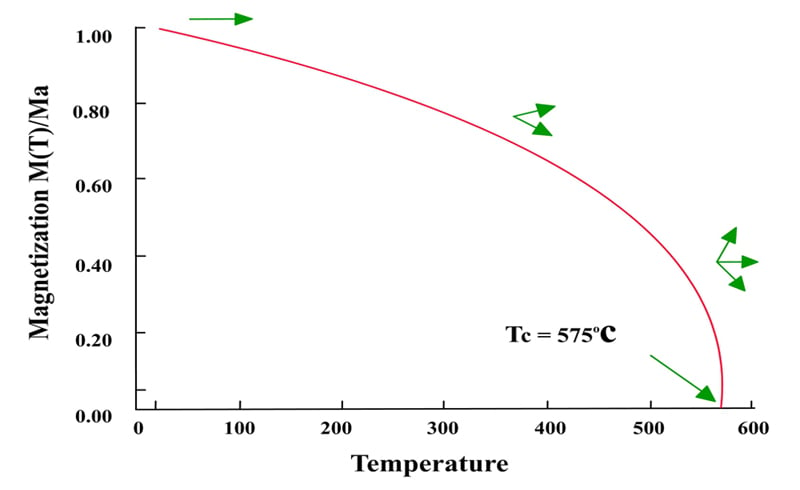
A magnet will regain its magnetic properties if it is heated to a temperature below the Curie point and then cooled (although a slight decrease in strength may be experienced). However, cooling a magnet after heating it beyond the Curie point will not help regain magnetism. In that case, an external magnetic field will need to be introduced to realign the domains and magnetize the material again.
While the application of heat is one of the primary methods for demagnetization, exposure to such high levels (ferrite magnets ~ 460°C, alnico magnets ~ 860°C, samarium cobalt magnets ~ 750°C, and neodymium magnet ~ 310°C) in everyday life is uncommon. The natural loss of magnetism mainly occurs due to one of the other factors.
Improper Storage
While it may seem trivial, proper storage of magnets is essential to ensure that they don’t lose their strength over time (and also, don’t harm your magnetic media, such as credit cards, hard drives, monitors, etc.)
Most magnets incorporate a healthy dose of iron, an element well known to corrode in the presence of oxygen and water. The most commonly used and strongest permanent magnets, neodymium magnets, are also the most vulnerable to corrosion due to their high iron content (more than 60%). Since corrosion changes the underlying chemical structure (Fe → Fe2O3) that makes a material magnetic, it leads to a loss in overall strength. Manufacturers have started incorporating anti-corrosion coatings, but care must still be taken when storing magnets.

A magnet incorrectly placed in the vicinity of another (stronger) magnet can also lose some or all of its magnetism. Similar poles of different magnets should never be allowed to touch each other (or be in close proximity), as the stronger magnet will force the weaker one’s magnetic domains to change direction; in some cases, a total reversal of poles may occur. This loss of magnetism due to an external (stray) magnetic field is known as hysteresis loss. Read more about this phenomenon here – What is the hysteresis curve?
Structural Damage
Finally, a general reduction in size or any structural damage will also cause a decrease in magnetic strength. Obviously, the magnetic field generated by magnets of the same material composition depends on the magnets’ size. The larger the magnet, the larger the magnetic field that will be generated. Structural damage in the form of chipping will take away from the size of the magnet and consequently, its magnetic strength.
Additionally, sharp impacts, like repeatedly hammering a magnet or dropping it on a hard surface, can force magnetic domains out of alignment and reduce magnetism. However, this is only true for certain permanent magnets. Neodymium, samarium cobalt, and ferrite magnets are quite brittle and will crack if dropped on a hard surface or hammered. Alnico magnets, on the other hand, are quite strong and won’t break or crack under mechanical stress.
A Final Word
To prolong the life of your magnets and prevent any loss of magnetic strength, store your magnets in a dry and isolated place. If multiple magnets are to be stored together, stick the north end of one to the south of another and so on; horseshoe magnets can also be stored like this. Additionally, consider using a keeper (armature)—a small piece of iron or steel—to avoid self-demagnetization and avoid damaging them entirely.
While multiple forces conspire to take your magnet’s powers away, the net decrease in magnetism over long periods is quite minuscule. For example, samarium-cobalt magnets take around 700 years to naturally lose half their strength, while neodymium magnets only lose about 5% of their magnetism each century.
So, you can rest assured that the permanent magnets currently sitting in your drawer will last you a lifetime and could even be passed down to your grandkids as family heirlooms!
References (click to expand)
- Introduction to Magnetism and Induced Currents. Rensselaer Polytechnic Institute
- Do magnets ever lose their magnetism?. hcmut.edu.vn
- Curie Point | UCSC Physics Demonstration Room. The University of California, Santa Cruz
- Peterson P. J. (1992). Corrosion of Electronic and Magnetic Materials. ASTM
- How to Properly Maintain Your Magnets. jobmastermagnets.com





